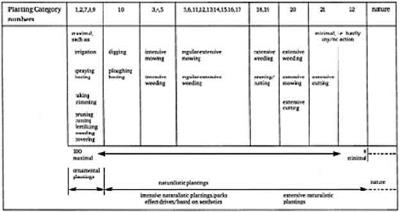In the following sections the practice of detailed maintenance and management will be dealt with. A number of vegetation units are discussed:
– woody plantings, plantings with trees and shrubs and woodland planting
– herbaceous undergrowth
– open vegetations and herbaceous vegetations of open spaces
– cultivated flower fields, cultivated fields rich in flowers and annual flower fields
– meadows rich in flowers
– water and water bank vegetations
– heath and bog vegetations
– rocky substratums, rocky environments and shallow soils.
Tables 10.1 and 10.2 place these naturalistic vegetations in the context of gradients of maintenance intensity and ‘naturalness’. In order to understand and to gain insight into the maintenance of naturalistic vegetations, practical experience is required and this must be continually added to. Experience is the crucial factor. Theoretical knowledge is totally different from the experience gained in dealing with plants and vegetations. Moreover, this practical experience should cover the complete range of succession. Experience with young and middle-aged naturalistic parks is indispensable in learning to understand and to gain insight into the maintenance of older naturalistic gardens, parks and vegetations. This type of experience contains all stages and variations, it is, in a manner of speaking, a holistic instrument.
Table 10.1 Planting type with cultural and natural maintenance
|
|
Table 10.2 Green management methods: the range from horticultural to natural
|
|
Only a limited representation of our experiences can be given in the next few sections. Practice offers one an almost unlimited range of management options. In fact, practice is different from one moment to the next, and it is exactly this that makes it so extremely interesting. Heempark management always poses challenges to be inventive and creative, using all the experience, caution and patience one possesses. Tree and shrub plantings will almost always be present. At the same time, there are always options for a rich herbaceous understorey. Within these parameters, the possibilities and, consequently, the sort of images one may realise are practically unlimited.





